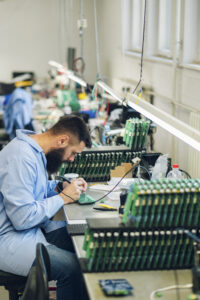
Shuming Zhu
Solution Architect
What If I told you AMI in partnership with NextDrive has a revolutionary solution for energy efficiency in small-scale data centers through real-time Power Usage Effectiveness (PUE) monitoring? This innovative solution is called AMI® Data Center Manager (DCM) – offers granular insights, empowering data center operators to improve their utilization and reduce their environmental impact. Let us take a look at how.
Data centers account for approximately 5% of global energy consumption. PUE is the most widely used performance metric, quantifying the ratio between total facility power usage and IT equipment power usage. A higher PUE indicates less efficient energy usage. By monitoring PUE, data center operators can continually improve energy efficiency, leading to more cost-effective data center operations.

The Need for Sustainability and Operational Efficiency
AMI DCM is an on-premises solution that collects inventory, power, thermals, health, and utilization data, aggregating it into a single-pane-of-glass. This enables data center operators and administrators to achieve sustainability goals while maximizing operational efficiency.
Previously, DCM used static PUE (nominal values), which proved effective for large-scale data centers with over 10,000 nodes. However, for smaller data centers with fewer than two hundred nodes, static PUE fails to accurately depict performance. For example, a single server shutdown can instantly alter the static PUE of a small data center. Real-time PUE monitoring is essential to accurately reflect performance in these scenarios.
Achieving Real-time Accuracy in PUE monitoring
To achieve real-time accuracy in PUE monitoring, NextDrive and AMI partnered to create a proof-of-concept (POC) using an AMI data center in Taiwan. As part of their Internet of Energy (IoE) services, NextDrive produces connected energy management devices, including Route B – a smart meter communication module, that can feed overall power data in real-time. DCM’s standout feature is gathering real-time power from IT equipment. By using the NextDrive Route B smart meter communication modules, DCM can map the energy consumption of the data center and its rooms. This real-time data allows DCM to calculate and display precise real-time PUE values over 24 hours. By leveraging the NextDrive Route B meter’s ability to collect power data every minute, DCM offers real-time (at the minutes level) PUE data accessible through the hierarchy page or via the RESTful API.
Data Center Manager Benefits
1. Level 3 Real-time PUE
AMI DCM offers Level 3 real-time PUE data for data centers, rooms, and racks in accordance with The Green Grid (TGG) definition for PUE measurement levels.
| Where do I measure? | Level 1 (L1) | Level 2 (L2) | Level 3 (L3) | |
| How often do I measure? | Basic | Intermediate | Advanced | |
| IT Equipment Energy | Required | UPS outputs | PDU outputs | IT equipment input |
| Total Facility Energy | Required | Utility inputs | Utility inputs | Utility inputs |
| Additional recommended measurements* |
UPS inputs/outputs Mechanical inputs |
PDU outputs UPS inputs/outputs Mechanical inputs |
||
| Measurement Intervals | Required | Monthly | Daily | 15 minutes |
| Additional recommended measurements* | Weekly | Hourly | 15 minutes of less | |
*Recommended measurements are in addition to the required measurements. Additional measurement points are recommended to provide further insight into the energy efficiency of the infrastructure.
2. Calculating Carbon Usage Effectiveness based on Real-time PUE
With the real-time PUE data, AMI DCM also provides Carbon Usage Effectiveness (CUE). CUE measures a data center’s environmental impact by comparing the total amount of carbon emissions from all sources to the amount of computing work done. CUE can be calculated as the product of the PUE and the Carbon Emissions Factor (CEF) for the data center’s region. Ideally, the CUE should be as close to 0.0 as possible.
![]()
3. Forecasting PUE Trends
AMI DCM has the capability to forecast PUE trends. The functionality utilizes predictive analytics to anticipate PUE trends, enabling proactive management and optimization of data center performance.
4. Rack Level PUE Data
AMI DCM provides a remarkably simple method for monitoring real-time PUE at the individual rack level. By interfacing directly with nodes and other IT equipment, AMI DCM can present data at various levels, from the entire data center to specific rooms, racks, rows, and node level. Many data centers need to monitor not only the PUE for their entire data center, but also to track the real-time PUE for each rack, especially those using liquid cooling systems.
Conclusion
The collaboration between AMI DCM and NextDrive represents a significant milestone in the evolution of data center management, offering a comprehensive solution to monitor real-time PUE and carbon emissions, and ultimately driving data centers towards a greener and more efficient future. This collaboration provides real-time PUE to data center managers. Additionally, AMI DCM offers IT Energy Efficiency (ITEE) and real-time carbon emissions data, further assisting organizations in achieving more sustainable and more cost-effective data centers.






